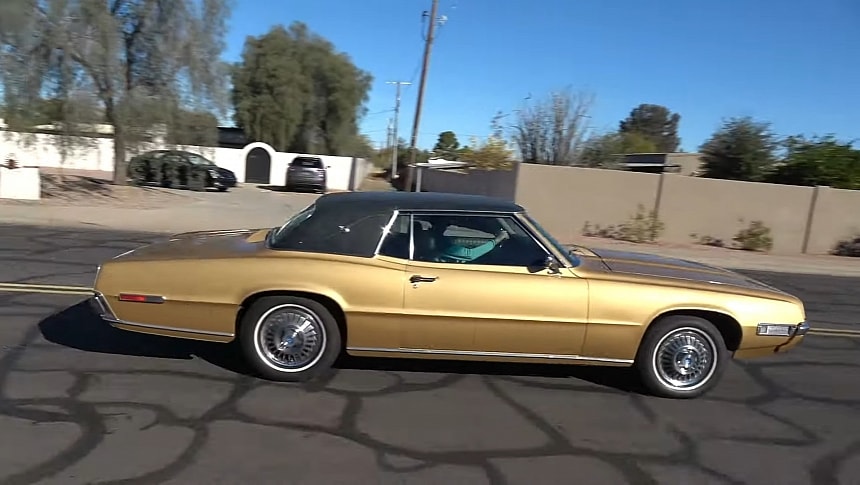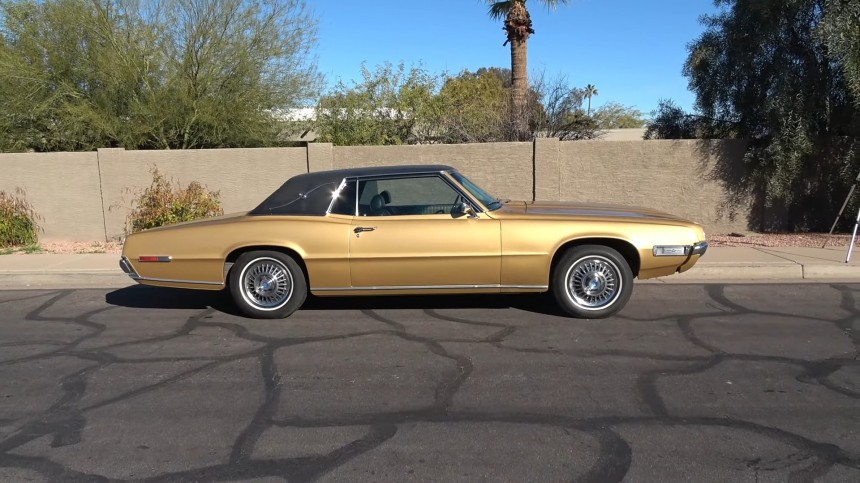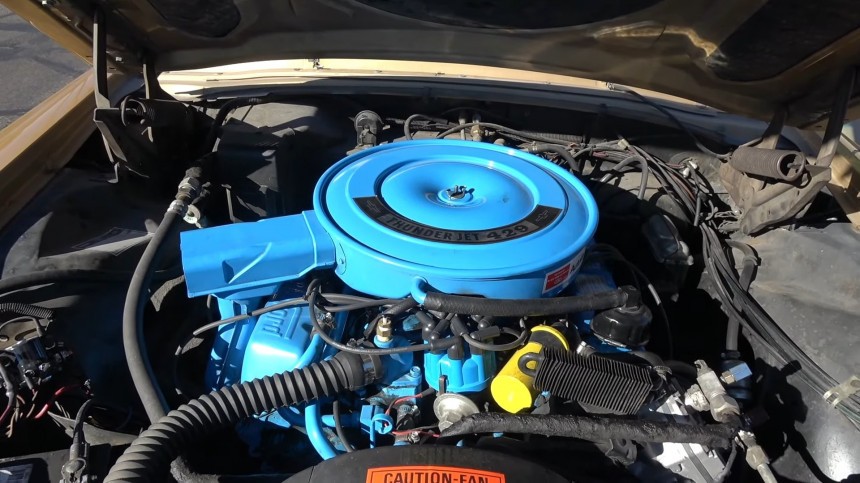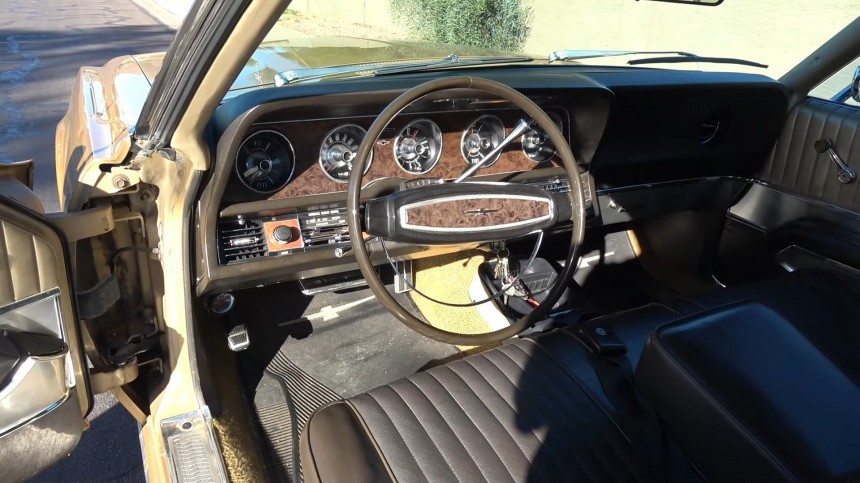The Mustang is the quintessential Ford automobile, although the Blue Oval is in no shortage of monumental achievements in the realm of piston power. Henry’s Ts and As are titans of the motorcar age, and the F-series trucks need no further introduction. And yet, the pony car is the shining star on the FoMoCo star-riddled sky. It was so blindingly bright that it overshadowed many of its siblings, forcing them to reposition if they were to have a chance.
The Thunderbird is another nameplate that felt the recoil of the Mustang's success in the mid-sixties. Following the launch of the youthful pony, the T-Bird – by then a two-door, two rows of seats platform itself – saw its market shrinking considerably. The personal luxury car philosphy of 1955 had to give the right of way to the impetuous wild stallion and its status symbol tenure.
So, in 1967, the Thunderbird was redesigned to avoid overlapping with the Mustang’s top-of-the-line versions. Sure, the two Fords were running for different buyers' niches. Still, the luxury model didn’t like competing against the spirited pony car. Ford leaned toward the ‘Luxury’ trait of the ‘personal luxury car’ nomenclature.
The manufacturer also changed its perspective on marketing, ditching the three-year generation production in favor of the five-year plan. When it came around in 1955, as a ‘not a sportscar’ two-door two-seater, the T-Bird immediately clawed the Corvette and thrashed the showroom floors with America’s sportscar.
In 1958, the second-generation Bird got a rear seat, and buyers loved it to the moon and back. Sales went through the roof – some 200,000 units in the three years of production, roughly 300% of the debut generation performance. The numbers stayed up for the following two generations; then Ford revised the model completely.
To emphasize the ‘luxurious’ demeanor, in 1967, the Thunderbird got an extra set of doors – and the idea was again well received, just like the addition of an extra bench had been in ’58. The Glamor Bird was airborne, and the more-doors were selling well. The platform was stretched out, and the Thunderbird was now inching closer (literally) to Lincoln territory than its former self.
During the fifth generation’s production, the T-Bird also got a new engine, the 429 big-inch (7.0-liter) V8 that spurred high-performance names like the Cobra Jet (and its Super twin brother) and the Boss Nine. The 1968 ‘Bird introduced the world to the new motor, and some fans of the nameplate will swear to Piston Almighty that it is one good engine.
Kelly Castle is one of those Ford guys with an appetite for Thunderbirds – he owns five of them, three of which are a ’67, a 68, and a ’69. He uses the 1968 model as a daily driver, fully trusting the rebuilds he performed on the 429, the automatic three-speed, and the rear end to make his to-and-fros enjoyable. Listen to this motor in the video below (courtesy of Lou Costabile again). The Thunder Jet big-block in the ‘Bird came with a healthy 360 hp and 480 lb-ft of torque (365 PS, 651 Nm) – more than enough for the car’s requirements.
The car below is a restoration; its current owner ran into an issue when redoing the interior. Coming out of the assembly line with gold seats over brown carpeting, the car now has brown upholstery with gold matting. The original combo was no longer available when Mr. Castle redid the cabin.
In January, the odometer showed 21,543 miles (34,663 km) when the video was shot in Phoenix, Arizona. It’s probably rolled over, judging by its looks. The 1968 production volume stopped just under the 65,000-unit mark, significantly dropping from the 78,000 examples built a year before. However, the downfall continued through 1969, when only 49,000 T-Birds were produced. All in all, the fifth-gen Ford Thunderbird's five-year run recorded 278,000 automobiles offered in two basic body styles.
The two-door hardtop was split into regulars and vinyl-roof landaus. The four-door sedan retained the Landau styling to complement the suicide doors. Over a dozen years, the Ford Thunderbird went full circle: from a somewhat British-looking two-seater a la AC Ace (the spiritual forefather of the Ford-powered Shelby Cobra) to a Lincoln Continental’s affordable alter ego.
The fifth generation of the nameplate also bid farewell to the drop-top variant. The feature would not be seen again on Thunderbirds until the 2002 two-seater revival, the last drop in the glorious bloodline of one of the greatest Fords ever. Kelly Castle (The Singing Mechanic) has five, all bought from 2016 onward. His passion for these not-so-common ‘Birds was sparked in high school when he purchased his first car, which happened to be a ’67 two-door.
That was in 1980, right around the time when these classy Fords started losing appeal – and their lives, particularly those with the 428s and 429s in them. While the automobiles weren’t necessarily interesting to most gearheads back then, the engines proved to be a treasure for restorers and other project-car enthusiasts, who would swap their Mustangs with the T-Bird-sourced big-blocks. Kelly went a different route, saving the cars altogether – he is a mechanic by trade, so it’s only natural that he wrenches his cars to factory settings, if not better.
So, in 1967, the Thunderbird was redesigned to avoid overlapping with the Mustang’s top-of-the-line versions. Sure, the two Fords were running for different buyers' niches. Still, the luxury model didn’t like competing against the spirited pony car. Ford leaned toward the ‘Luxury’ trait of the ‘personal luxury car’ nomenclature.
The manufacturer also changed its perspective on marketing, ditching the three-year generation production in favor of the five-year plan. When it came around in 1955, as a ‘not a sportscar’ two-door two-seater, the T-Bird immediately clawed the Corvette and thrashed the showroom floors with America’s sportscar.
To emphasize the ‘luxurious’ demeanor, in 1967, the Thunderbird got an extra set of doors – and the idea was again well received, just like the addition of an extra bench had been in ’58. The Glamor Bird was airborne, and the more-doors were selling well. The platform was stretched out, and the Thunderbird was now inching closer (literally) to Lincoln territory than its former self.
During the fifth generation’s production, the T-Bird also got a new engine, the 429 big-inch (7.0-liter) V8 that spurred high-performance names like the Cobra Jet (and its Super twin brother) and the Boss Nine. The 1968 ‘Bird introduced the world to the new motor, and some fans of the nameplate will swear to Piston Almighty that it is one good engine.
The car below is a restoration; its current owner ran into an issue when redoing the interior. Coming out of the assembly line with gold seats over brown carpeting, the car now has brown upholstery with gold matting. The original combo was no longer available when Mr. Castle redid the cabin.
In January, the odometer showed 21,543 miles (34,663 km) when the video was shot in Phoenix, Arizona. It’s probably rolled over, judging by its looks. The 1968 production volume stopped just under the 65,000-unit mark, significantly dropping from the 78,000 examples built a year before. However, the downfall continued through 1969, when only 49,000 T-Birds were produced. All in all, the fifth-gen Ford Thunderbird's five-year run recorded 278,000 automobiles offered in two basic body styles.
The fifth generation of the nameplate also bid farewell to the drop-top variant. The feature would not be seen again on Thunderbirds until the 2002 two-seater revival, the last drop in the glorious bloodline of one of the greatest Fords ever. Kelly Castle (The Singing Mechanic) has five, all bought from 2016 onward. His passion for these not-so-common ‘Birds was sparked in high school when he purchased his first car, which happened to be a ’67 two-door.
That was in 1980, right around the time when these classy Fords started losing appeal – and their lives, particularly those with the 428s and 429s in them. While the automobiles weren’t necessarily interesting to most gearheads back then, the engines proved to be a treasure for restorers and other project-car enthusiasts, who would swap their Mustangs with the T-Bird-sourced big-blocks. Kelly went a different route, saving the cars altogether – he is a mechanic by trade, so it’s only natural that he wrenches his cars to factory settings, if not better.































